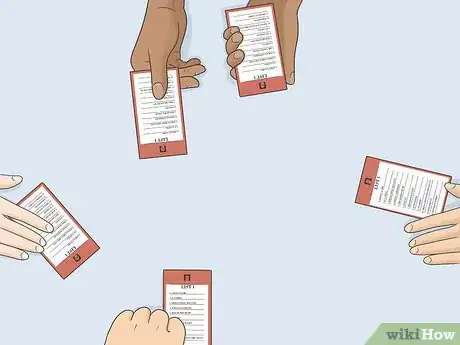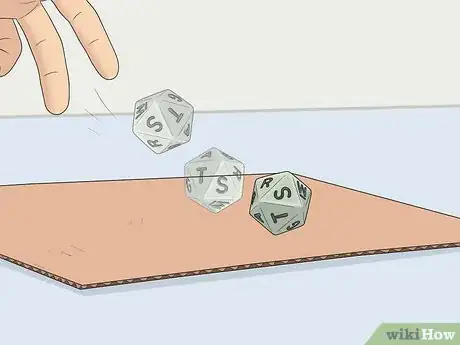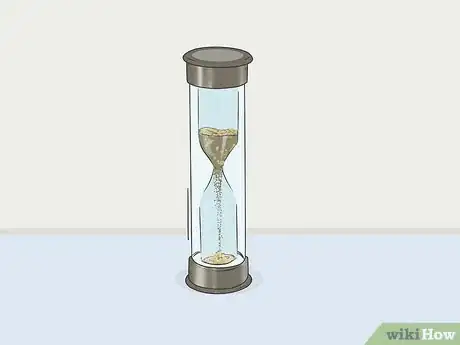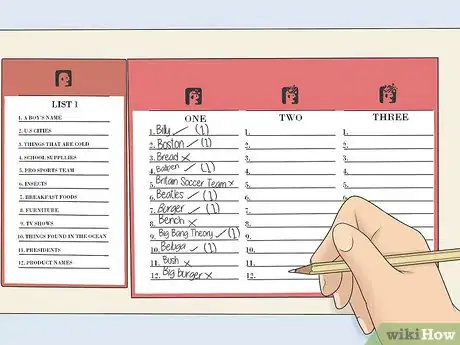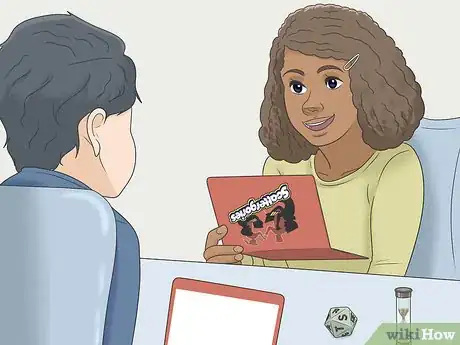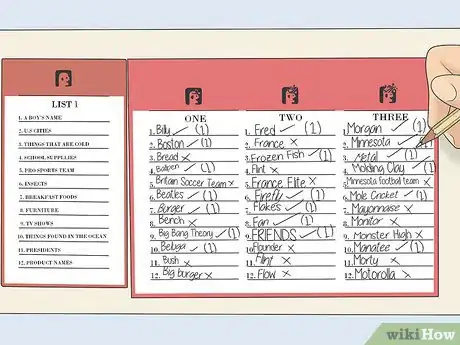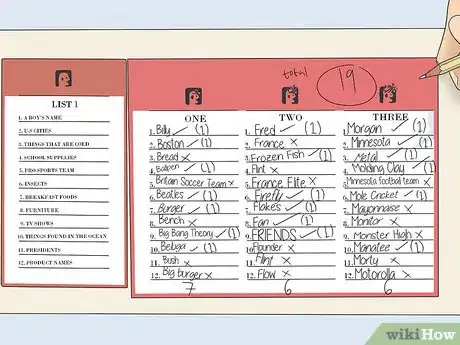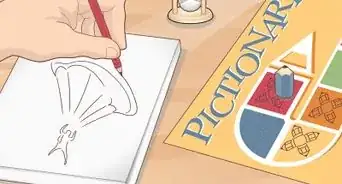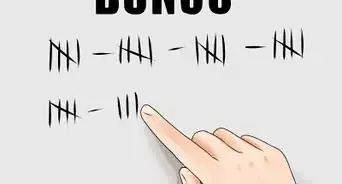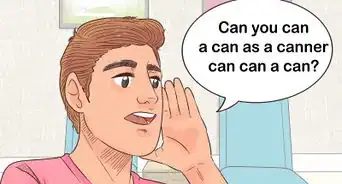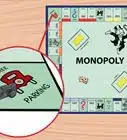This article was co-authored by wikiHow Staff. Our trained team of editors and researchers validate articles for accuracy and comprehensiveness. wikiHow's Content Management Team carefully monitors the work from our editorial staff to ensure that each article is backed by trusted research and meets our high quality standards.
This article has been viewed 129,856 times.
Learn more...
Scattergories is a party game manufactured by Hasbro. It is intended for two or more players, ages 13 and up. Players compete by making lists of words that all start with the same letter. You'll score one point for every word you put on your list that no one else puts on theirs. At the end of the game, the winner is whoever has the most points.
Steps
Setting up the Game
-
1Get two or more players together. Scattergories is recommended for two or more players, so you will need at least one other person to play. If there are only two of you, though, the game can end up being slow and quiet, and so not as fun. If you have a large number of players, it can also be fun to play Scattergories with teams. For example, if there are six of you, then you can divide into two teams of three or three teams of two.[1]
-
2Make sure each player has everything they need to play the game. The current edition of the game comes with an hourglass timer, a 20-sided die, six cardboard folders, six copies of each of the 13 category cards, and a pad of answer sheets. Each player or team will need a folder, an answer sheet, and pens or pencils to play the game. Insert one answer sheet into the slot in your (or your team's) folder.[2]
- Each answer sheet has three columns, one for each round of the game. Each column has spaces for 12 answers.
- Older editions of the game came with pencils, but newer ones do not. You should make sure that everybody who wants to play has something to write with.
Advertisement -
3Set out a die-rolling surface. The 20-sided die that comes with the Scattergories game is large and heavy. It might damage surfaces made from glass or soft wood. If you are worried about damaging your playing surface, put out a piece of cardboard to roll the die on.[3]
- Older editions of Scattergories may include a die-rolling board along with the other components of the game.
Playing the Game
-
1Give each player or team one copy of the same category card. This is the category card that everybody will use during the first round of the game. Each category card shows 12 different categories. [4]
- The game also comes with blank category cards so you can make your own categories if you want.
-
2Roll the die to select a letter. Scattergories comes with a 20-sided die that shows every letter of the alphabet except for Q, U, V, X, Y, and Z, as it can be challenging to think of a wide enough variety of words that start with these letters. To select the letter that you will use in the first round, roll the die and announce the letter that comes up to the other players.[5]
-
3Start the timer. Scattergories includes an hourglass that takes around three minutes to run out. Once the letter has been announced, make sure all the players are ready. Then turn over the hourglass to start the first round.[6]
- If you want a more challenging game, everyone can agree to take less time than three minutes for each round. Instead of using the hourglass, set the timer on your phone or watch to the desired amount of time.
- Older editions of Scattergories may come with a mechanical timer instead of an hourglass. To operate the mechanical timer, you will need to insert two new AAA batteries into the battery compartment. One difference in using the mechanical timer instead of the hourglass is that the mechanical timer can be set for periods of less than three minutes, while the hourglass cannot.
-
4Write down one word for each of the 12 categories in that round. You'll have three minutes to write one answer in the first column of the answer sheet for each of the 12 categories shown on the category cars. All answers must start with the letter rolled on the die at the start of the round. For example, if one of the categories is “A Boy's Name” and the letter you rolled was “P,” then you might choose “Phil” as your answer for that category.[7]
- The words “a,” “an,” and “the” don't count if they're the first word of an answer. For example, if the category is “Movie,” then “The Dark Knight” would be an appropriate answer for the letter D, but not for the letter T, as the word “the” doesn't count.
- A person's name counts if either their first name or their last name starts with the selected letter. For example, if you rolled the letter J and one of the categories is “Basketball Player,” then both “Julius Irving” and “Michael Jordan” are appropriate answers.
- If you are playing as part of a team, be sure to write down any answers you want to suggest instead of saying them out loud. You don't want your opponents to steal your answers!
- To keep your opponents from seeing the answers you write down, hold up the upper flap of your folder so they won't be able to see your answer sheet.
-
5Give yourself (or your team) one point for every unique answer. Each player or team gets one point for every answer they have that no one else has. For example, let's say that one of the categories is “A Boy's Name” in a game with four players. You write “Phil” as your answer. Player 2 writes "Peter" as their answer. Player 3 and Player 4 both write “Paul” as their answers. You and Player 2 both get one point, as you both had unique answers. Since Player 3 and Player 4 both had the same answer, neither of them get any points for that category.[8]
- One optional variation of Scattergories gives extra points for answers that use alliteration. If an answer consists of more than one word, you get one point for each word that starts with the selected letter. For example, if the category is “Movie Character” and the letter rolled was “P,” then “Pocahontas” or “Phil Coulson” would be worth one point each, while “Peter Parker” would be worth two points.
-
6Challenge other players' answers if you think they don't fit the category. Since everybody is trying to make sure that their answers are unique, they might come up with creative answers that don't quite fit within a specific category. When this happens, you can challenge another player's answer and put it to a vote. If the majority of players believe that an answer doesn't fit the category, then the player who wrote it doesn't get points for that answer. If the votes are tied, then the challenged player's vote doesn't count.[9]
- For example, let's say the category is “Animal” and the letter is “J.” There are four players. You write down the answer “jackalope,” which is a fictional animal. When all the players are tallying points at the end of the round, Player 2 objects that since the jackalope is not a real animal, you shouldn't get points for that answer. All players then vote on whether “jackalope” counts as an animal or not. You and Player 3 vote “yes,” while Player 2 and Player 4 vote “no.” Since there is a tie, your vote doesn't count. The vote is then two to one against accepting “jackalope” as an animal, so you don't get any points for that answer.
-
7Play rounds two and three. At the beginning of each round, give each player or team one copy of a new category card. Roll the die to select a new letter, but re-roll if you get the same letter that you used in any previous round. Play rounds two and three just as you did round one, but write the answers in the corresponding column of the answer sheet.[10]
-
8End the game by tallying the points for all three rounds. At the end of round three, each player or team adds up all the points they earned in all three rounds. The player or team with the highest point total is the winner.[11]
Things You'll Need
- A copy of the game
- Pens or pencils
- A die-rolling surface (optional)
- A phone, watch, or other timer (optional)
References
- ↑ http://www.andrelim.com/2014/01/scattergories.html
- ↑ https://www.youtube.com/watch?v=qWCDn3tBtDs
- ↑ https://www.hasbro.com/common/instruct/Scattergories_%282003%29.pdf
- ↑ https://www.youtube.com/watch?v=qWCDn3tBtDs
- ↑ http://www.andrelim.com/2014/01/scattergories.html
- ↑ https://www.hasbro.com/common/instruct/Scattergories_%282003%29.pdf
- ↑ https://www.hasbro.com/common/instruct/Scattergories_%282003%29.pdf
- ↑ https://www.hasbro.com/common/instruct/Scattergories_%282003%29.pdf
- ↑ https://www.hasbro.com/common/instruct/Scattergories_%282003%29.pdf
About This Article
Scattergories is a fun 2-6 player game where players try to score points by listing words that start with the same letter in a specific category. To start the game, give each player a pile of category cards and a scoresheet, which has 3 columns on it—1 for each round of the game. Choose one category card to start with and have each player put that card on top of their pile face up. Then, roll the 20-sided letter die and start the 3-minute timer. Players then begin filling in their answer sheet with words that fit the chosen category and start with the letter rolled on the die. For example, if the letter on the die is “C” and the category is “Places,” players could write “Chicago,” “Congo,” “Charlotte,” and so on. The articles “a,” “an,” and “the” do not count towards the letter requirement, and multi-word answers count if the first letter in the first word matches the letter on the die. When using proper names, you are allowed to place the last name first. For example, if the category is “Historical Figures” and the letter is “W,” an answer of “Washington, George” would be acceptable. Creative answers also count. For example, if the category is “Sandwiches,” then “Knuckle” would be acceptable. Once the timer runs out, players stop writing and take turns reading their list of words. If any players disagree with another player’s answer, they can challenge it, and each player votes on whether the answer in question is acceptable or not. If the majority of players vote against it, or if the vote is a tie, the word is rejected. If any players come up with identical answers, every player that wrote that answer down crosses it off of their sheet. Once every player has read their answers, each player circles every answer that isn’t crossed out. Players get 1 point for each circled answer. Each player jots down the total number of points for the round at the top of that column. Then, the second round begins. Use the same category card, but reset the timer and roll the die to get a new letter. If you roll the same letter as the previous round, re-roll the die. The player with the most points at the end of three rounds is the winner.



